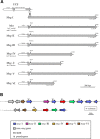Is the unique camouflage strategy of Pneumocystis associated with its particular niche within host lungs?
- PMID: 30677096
- PMCID: PMC6345417
- DOI: 10.1371/journal.ppat.1007480
Is the unique camouflage strategy of Pneumocystis associated with its particular niche within host lungs?
Conflict of interest statement
The author has declared that no competing interests exist.
Figures

References
-
- Latinne A, Bezé F, Delhaes L, Pottier M, Gantois N, Nguyen J, Blasdell K, Dei-Cas E, Morand S, Chabé M (2018) Genetic diversity and evolution of Pneumocystis fungi infecting wild Southeast Asian murid rodents. Parasitol 145: 885–900. - PubMed
-
- Ma L, Chen Z, Huang DW, Kutty G, Ishihara M, Wang H, Abouelleil A, Bishop L, Davey E, Deng R, Deng X, Fan L, Fantoni G, Fitzgerald M, Gogineni E, Goldberg JM, Handley G, Hu X, Huber C, Jiao X, Jones K, Levin JZ, Liu Y, Macdonald P, Melnikov A, Raley C, Sassi M, Sherman BT, Song X, Sykes S, Tran B, Walsh L, Xia Y, Yang J, Young S, Zeng Q, Zheng X, Stephens R, Nusbaum C, Birren BW, Azadi P, Lempicki RA, Cuomo CA, Kovacs JA (2016) Genome analysis of three Pneumocystis species reveals adaptation mechanisms to life exclusively in mammalian hosts. Nat Commun 7: 10740 10.1038/ncomms10740 - DOI - PMC - PubMed
-
- Keely SP, Renauld H, Wakefield AE, Cushion MT, Smulian AG, Fosker N, Fraser A, Harris D, Murphy L, Price C, Quail MA, Seeger K, Sharp S, Tindal CJ, Warren T, Zuiderwijk E, Barrell BG, Stringer JR, Hall N (2005) Gene arrays at Pneumocystis carinii telomeres. Genetics 170: 1589–600. 10.1534/genetics.105.040733 - DOI - PMC - PubMed
Publication types
MeSH terms
LinkOut - more resources
Full Text Sources

